The wiring system is impossible without the installation of sockets. Devices and equipment will not work without power access points. At the same time, the magnitude of the load on the power supply network in the modern world is very high, therefore it is important to carry out the correct serial connection of the sockets.
Existing connection methods
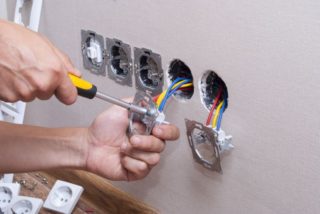
Sockets in the amount of more than two pieces are connected in three ways: in series, in parallel and mixed. Electricians use other terms - a star (for the first option), a loop (for the second). Before choosing one of the methods, you need to find out the pros and cons of each, and choose the one that suits your particular apartment.
If an electrical installation is installed in the room, it is important to consider the cabling method and the total available power. New ones can exceed the limit, the wire will have to be pulled from the shield.
Parallel connection
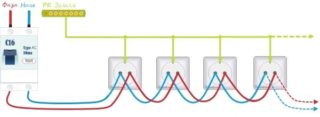
The essence of the method is to connect outlets in one distribution block, which accounts for the entire load when the electrical equipment is turned on. A cable is pulled from the general house panel to the junction box, and wiring is pulled from it to each power point (separate wires).
The advantage of this method is the independent operation of each power point and switch. If one device burns out, the others will continue to work. But if the main wire becomes unusable, the voltage will disappear completely. In such a situation, it is easier to find the gap and fix the malfunction.
Another disadvantage is cable consumption. For each outlet, a separate wire is pulled from the junction box. The length is considerable.
Serial connection
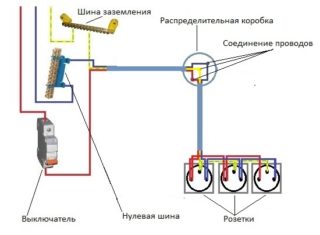
Daisy chain connection means a sequential transition from the first outlet to the next. Instead of twisting wires, device contacts are used. Phase and zero cables are connected to the first mechanism, then to the next and sequentially to the last.
The "pure form" method is rarely used. For example, if you need to install an additional outlet or switch, or move one of the devices at a certain distance. In the second situation, the old access point is left, from it they lead to a new place - this way you will have to cut the walls less.
It is forbidden to connect devices with high power to the sockets connected by a loop. Air conditioners, microwave ovens and ovens, washing machines and other similar devices must be powered from other access points. In a daisy-chain system, many outlets are connected to the same network, so the load falls on each.
Mixed connection and ground connection in series
If you decide to use a series connection of sockets, you can strengthen the overall design using a mixed method. The essence of the method is as follows:
- A central cable is brought to the junction box from the general house panel.
- On the preliminary wiring plan, the most distant power access point is selected.
- The selected socket is connected from the junction box cable.
- The rest are powered from this device.
This method improves the reliability of the network. If the outlet fails, the others continue to work.Disconnection of the entire system is possible only in the event of a malfunction of the main cable, twisting in the junction box.
Grounding is a must. With a serial connection, if the wire burns out at one point, the rest are obtained without protection. The best way to connect the sockets to each other for grounding is mixed. The main cable is fixed to the ceiling, then branches are made to each access point.
This technique has disadvantages - the long length of the wires used, the need to install several distribution boxes (for each branch). In order to know for sure whether high-power devices can be connected to the network, it is necessary to calculate the voltage before the cabling stage. An accurate calculation will help you choose how to connect the sockets in the end - in series, parallel or mixed.
Ring connection
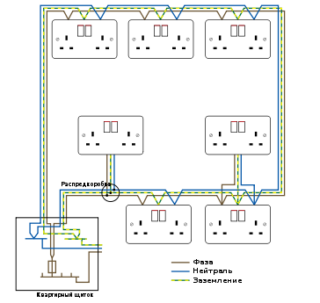
This type of connection is rare in post-Soviet countries. The method has a number of indisputable advantages, therefore, it has been gaining popularity lately.
How to correctly connect the sockets to each other with a ring connection:
- From the main (common house) panel to the apartment (house, dacha), a common cable is routed around.
- In each room (room), a tie-in is made on the main wire, a junction box is installed and a separate circle is drawn to a separate room.
- In the last turn, branches are made to each access point.
If one part of the wire burns out or breaks, the devices continue to work with the ring connection, because electricity comes from the other side of the ring. It still needs to be repaired, but the power supply will remain. The reliability of the system is comparable to the parallel connection of outlets. Minus - wire consumption is higher compared to classical methods.
How to choose the right way
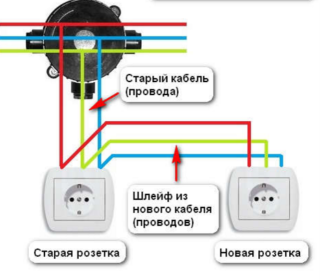
To choose a parallel or serial connection of sockets, it is necessary to calculate several parameters: the amount of funds that can be spent on electrical wiring, equipment power and wall decoration (the ability and desire to redo repairs in case of breakdowns).
The best way is to connect two sockets to one wire of the shield or junction box - parallel connection. If the room does not have a large number of outlets and appliances (for example, only a TV), the loopback method will do.
Is it possible to connect sockets in series
Connecting outlets in serial mode has a number of disadvantages and limitations. In a large room and a significant number of powerful electrical appliances, this method cannot be used - the load is too high. It is better to parallelize the sockets or use the ring type. The recommended quantity per chain is 5-6 pieces.
Another disadvantage is the uneven distribution of voltage at the power points. Each outlet accounts for a portion of the total electrical flow. Therefore, in residential and industrial premises, a serial connection is not used. But you can use it in Christmas tree garlands and others.
Pros and cons
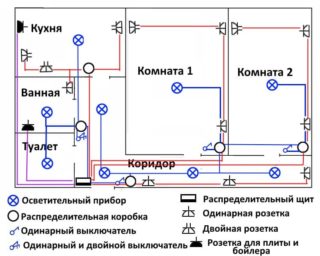
To determine the optimal wiring diagram for sockets and switches, it is necessary to prepare a wiring plan, calculate the number of devices and the possible maximum power. At the same time, in newly built buildings, it is necessary to plan future opportunities without undue modesty: an additional TV, the purchase of a separate freezer, and the like.
Based on the data received, the type of connection is selected. The advantages of the sequential method include:
- simple connection system and circuit assembly;
- the ability to adjust the voltage level, make it less;
- one fuse per circuit can be used.
The minus becomes obvious after the appearance of malfunctions - if one outlet breaks, the rest will not work.
Compliance with safety measures when installing sockets
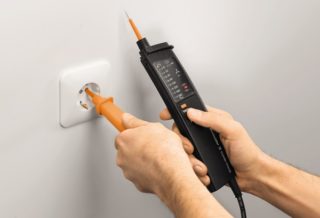
Work with electricity is classified as hazardous. Even a small amount of stress leads to burns, injuries and other unpleasant consequences. Compliance with safety precautions:
- de-energize the room in which the work is carried out;
- check the site before starting with a special device (you can turn on the device to the network);
- use rubber gloves, equipment with rubberized handles;
- when "building up" the length, it is not enough to twist the wires, a soldering is required;
- contact with connected bare cables is not allowed;
- surplus should not "stick out" - shorten, lay in the wall;
- check whether the devices are suitable for the current and voltage levels used.
Anyone can connect the sockets in the indicated ways. Circuits have advantages and disadvantages, before making the final choice, it is important to set the power of the equipment and the method of branching the wiring.

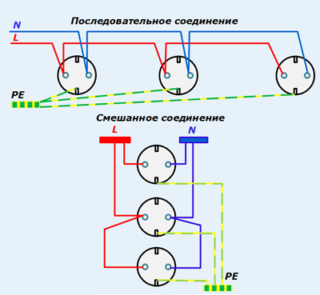








What the hell is the SERIAL CONNECTION of outlets? Serial connection of bulbs, I agree. But sockets? The sockets are not connected in series, in parallel - no question, but in series ....?
They are connected, but only (!) In the case of using low-power devices